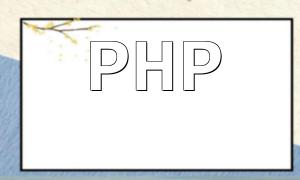In real-time chat systems, user authentication and authorization mechanisms are crucial. Properly validating user identities and performing authorization can effectively protect the system's security and user privacy. This article explains how to implement these mechanisms using PHP, with relevant code examples provided.
User authentication verifies whether the information provided by the user matches the identity information stored in the system. In real-time chat systems, authentication is typically done using usernames and passwords.
Below is a simple example of user authentication:
<?php
// User login interface
function login($username, $password) {
// Query user information from the database
$user = getUserByUsername($username);
if ($user && $user['password'] == md5($password)) {
// Username and password match, login successful
return true;
} else {
// Username or password is incorrect, login failed
return false;
}
}
// Get user information
function getUserByUsername($username) {
// Code to query user information from the database
// This is just an example, the specific implementation should be written based on the actual situation
}
// Call the login interface
$result = login('testuser', '123456');
if ($result) {
echo "Login successful";
} else {
echo "Login failed";
}
?>
In the code above, the login() function takes the username and password as parameters and queries the user information in the database. If the user exists and the password matches, login is successful; otherwise, login fails.
To increase login security, passwords are usually hashed using functions like md5() or other encryption algorithms.
The user authorization mechanism verifies whether a user has permission to perform a certain operation or access specific resources. In real-time chat systems, session management can be used to implement user authorization.
Below is a simple example of user authorization:
<?php
// Authorization function to check if the user has permission to perform an operation
function checkPermission($userId, $operation) {
// Get user permissions
$permissions = getUserPermissions($userId);
// Check if the user has permission for the operation
if (in_array($operation, $permissions)) {
return true;
} else {
return false;
}
}
// Get user permission list
function getUserPermissions($userId) {
// Code to query user permissions from the database
// This is just an example, the specific implementation should be written based on the actual situation
}
// Call the authorization function
$userId = 123; // Assume the user ID is 123
$operation = 'send_message'; // Assume the operation is sending a message
if (checkPermission($userId, $operation)) {
echo "You have permission to perform this operation";
} else {
echo "You do not have permission to perform this operation";
}
?>
In the code above, the checkPermission() function takes the user ID and operation as parameters, queries the user's permission list from the database, and checks if the user has permission for the operation. If the user has the required permission, it returns true; otherwise, it returns false.
Permissions can be stored in the database, cache, or other places, and the specific implementation depends on the actual needs.
User authentication and authorization are critical components of real-time chat systems. By properly validating user identities and performing authorization checks, the security of the system and the protection of user privacy can be ensured. This article explained the basic methods of implementing these mechanisms using PHP, with relevant code examples. In real-world applications, developers should adjust and optimize these mechanisms based on specific needs and system environments to ensure the security and reliability of the chat system.









